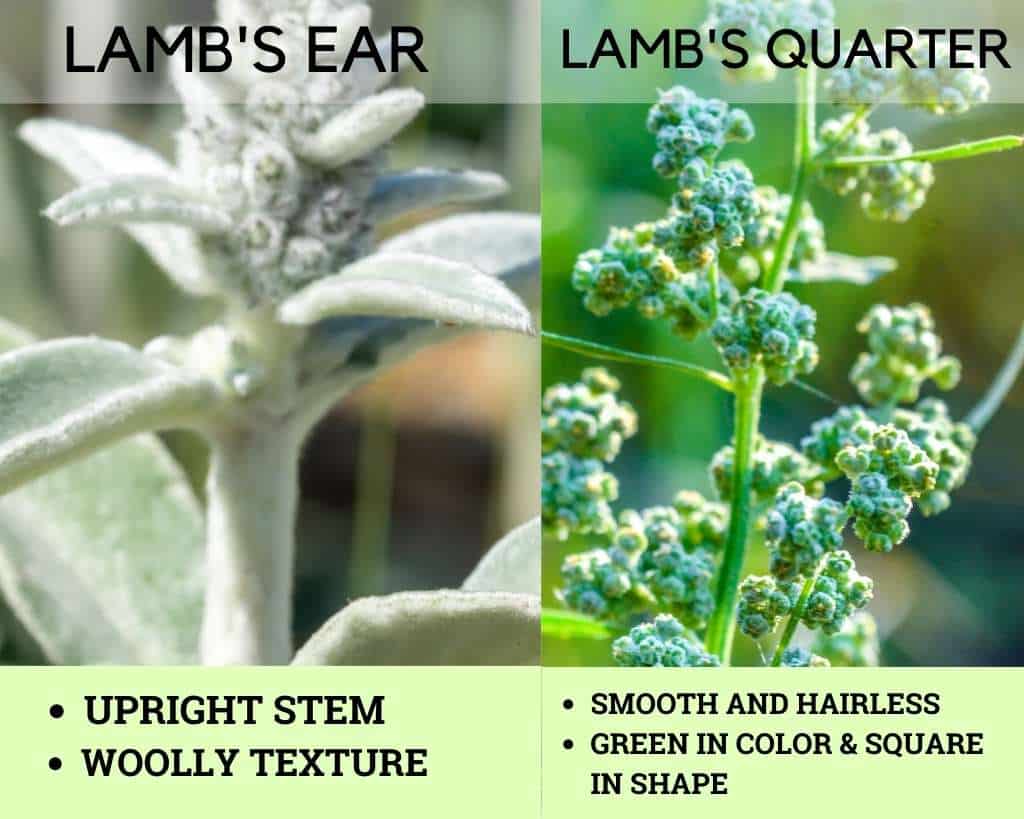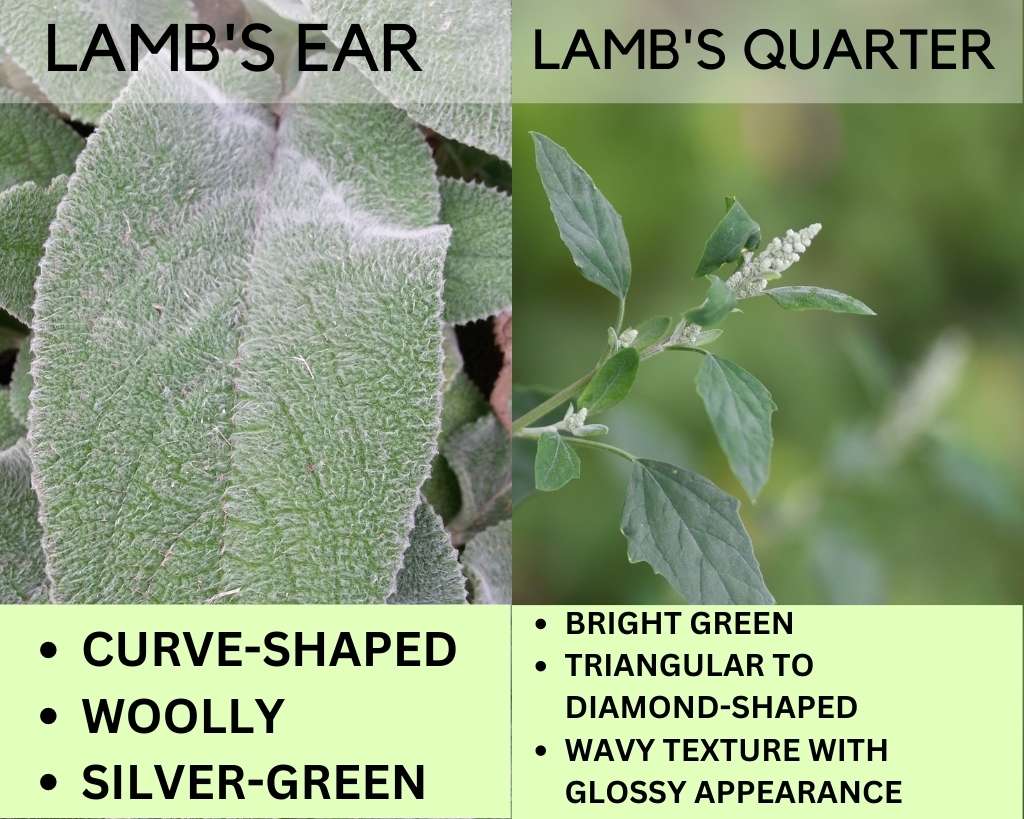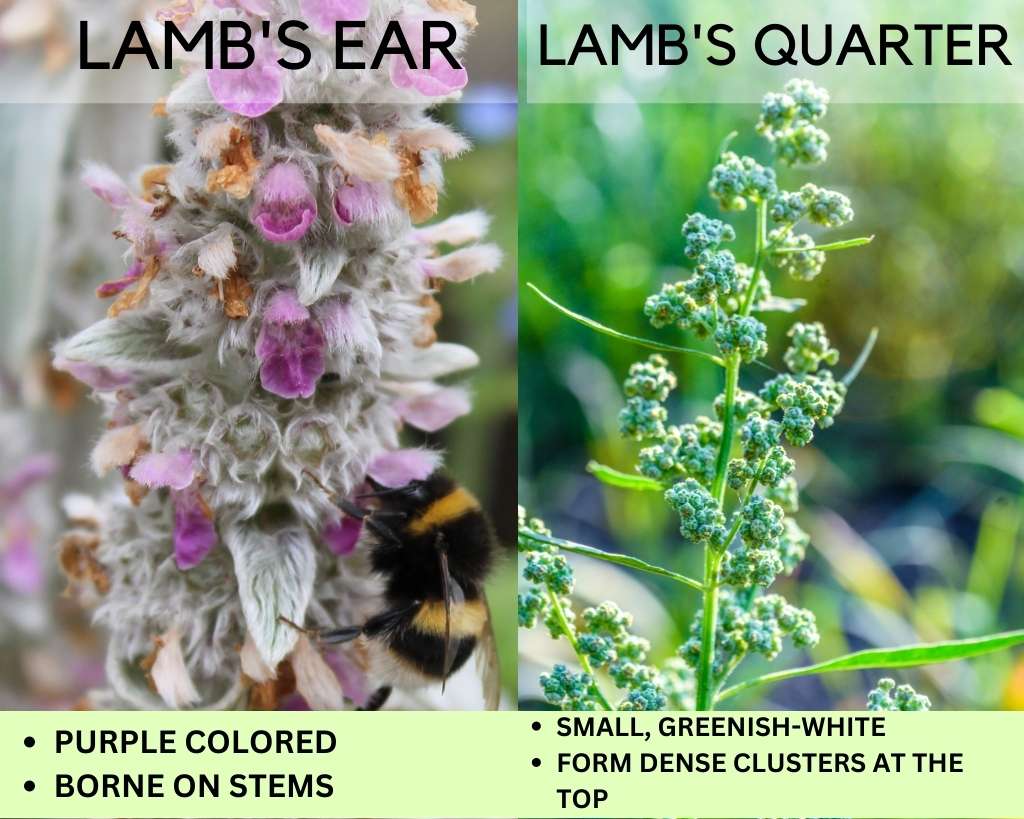If you’re a gardener or someone who loves to learn about different plants, you may have come across Lamb’s Ear and Lamb’s Quarter. Both these plants are known for their fuzzy foliage and the common term “lamb” in their names.
The triangle-shaped leaves of Lamb’s Quarter are different from the curve-shaped leaves of the Lamb’s Ear plant. Many gardeners are often confused by their names and consider them the same plants. However, Lamb’s Ear got its name because of the fuzzy gray-green leaves that resemble the ears of a lamb.
The name “lamb’s quarter” is thought to come from the fact that lambs often eat the plant or that it is commonly found growing in fields where lambs graze. Additionally, the leaves of the plant are similar in shape to a quarter of a lamb’s hoof.
| Lamb’s Ear | Lamb’s Quarter | |
| Name | Stachys byzantina | Chenopodium album |
| Zones | 4-9 | 3-9 |
| Height | 1-2 feet | 1-3 feet |
| Width | 1-2 feet | 3 feet |
| Sunlight | Full sun to partial shade | Full sun to partial shade |
| Soil | Well-Drained | Well-Drained |
| Lifespan | Perennial | Annual |
| Origin | Middle-East | Europe, Asia and Africa |
| Family | Lamiaceae | Amaranthaceae |
| Propagation | Seeds, Division | Seeds, Cuttings, Division, Layering |
| Diseases | powdery mildew and rust | powdery mildew, fusarium wilt |
| Pests | slugs and snails | Aphids, Thrips, Flea beetles |

Lamb’s Ear vs Lamb’s Quarter – Key Differences
We will discuss some essential points regarding Lamb’s Ear vs Lamb’s Quarter which will further help you to clear the confusion surrounding both these plants.
Plant Size
Lamb’s Ear plant reaches up to 1-2 feet in height and can spread up to 2 feet as well.
The average plant height of Lamb’s Quarter is 1-3 feet. Although, areas with proper sunlight and optimal growing conditions can help the plant reach up to 8 feet in height.
Also Read: Lamb’s Ear vs Mullein: Which is Better for Your Garden?
Stems

The stem of Lamb’s Ear is usually short and stubby, and it is covered in fine, soft hairs that give it a velvety texture. The stem structure is typically not very visible as the leaves are large and cover the stem.
Lamb’s Quarter, on the other hand, has a different stem structure. It is typically tall and thin, with a green or red-tinged color. The stem is smooth and hairless and may be slightly grooved or ridged.
Leaves – color, shape, size, and texture

The curved shaped, fuzzy, silver-gray leaves of Lamb’s Ear are the most attractive part of the plant. Gardeners love to plant it in their landscape gardens just because of the texture and color of the leaves. Kids also love to touch the leaves.
Lamb’s Quarter, on the other hand, has a different leaf structure. The leaves are green, slightly rough to the touch and can be alternate or opposite on the stem. They are typically simple, meaning they are not divided into smaller leaflets. The leaves are often triangular or diamond-shaped and have a slightly wavy or lobed margin.
Also Read: Lamb’s Ear vs Comfrey: A Head-to-Head Comparison
Flowers

The flowers of Lamb’s Ear are small, pink or lavender in color and arranged in spikes or clusters on tall, slender stems. From early spring to late summer, the flowers start to bloom. The slight pinkish or purple-colored flowers form a dense group on top of the main stem. These spikes are usually about 6 inches tall and are positioned above the foliage.
Lamb’s Quarter, on the other hand, has small, green flowers arranged in dense clusters at the top of the plant. These flowers are typically not showy and are not commonly grown for ornamental purposes. The flowers are arranged in groups, called spikes, about 1-2 inches long and are greenish-white to yellow. They bloom in summer or early fall.
Benefits
Lamb’s Ear thrives in dry climates and is a well-known groundcover plant that is drought-tolerant. It doesn’t require special care to thrive. It is a vigorous plant that is resistant to most pests and diseases. Additionally, it is a good attraction plant for bees and butterflies.
Lamb’s Quarter is known for being rich in vitamins A, C, and K and minerals such as iron and calcium. It can be used as a green leafy vegetable and is often used in traditional cuisines worldwide. It can be a good companion plant for your garden because it can repel some pests and diseases that might affect crop growth.
Also Read: 6 Plants Similar to Lamb’s Ear
Drawbacks
The most crucial drawback of growing both these plants is their invasive nature. Despite the lot of benefits that plants possess. It can be tiring for a gardener to stop both plants from invading your garden. However, careful measures such as mulching, mowing and monitoring these plants’ growth patterns can help control their invasive tendencies.
Is Lamb’s quarter poisonous?
Lamb’s quarter can contain high levels of nitrates, which can be toxic if consumed in large amounts. it’s best to cook it thoroughly and consume it in small amounts.
Can we grow Lamb’s Ear and Lamb’s Quarter as companion plants?
it’s possible to grow Lamb’s ear and Lamb’s quarter as companion plants, it’s not a common practice, and it’s not recommended to do so. It’s best to keep them separated to prevent invasiveness and potential damage to other plants.




